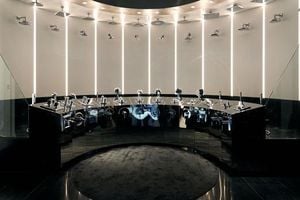The "Finsmeira" group has announced a significant investment of 859 million dirhams, aimed at establishing a series of retail jewelry stores and advanced manufacturing units in the UAE and India. This initiative, which will unfold over the next two years, marks a substantial expansion for the company, particularly in the UAE where it plans to open main showrooms in Abu Dhabi and Dubai, along with another in Sharjah and a modern production facility in Sharjah.
The UAE's strategic position as a global hub for jewelry trade is expected to benefit from the operational activities of Finsmeira, as they cater to both retail and wholesale markets. The existing manufacturing unit in Sharjah, which spans 50,000 square feet, is already one of the largest in the region and adheres strictly to environmentally friendly practices, including the use of hydrogen fuel, underscoring Finsmeira's commitment to sustainability.
Dinesh Kambrath, co-founder of Finsmeira, articulated the company's vision, stating, "Finsmeira aims to pave the way for a new era of excellence in jewelry production and retail, seamlessly blending heritage with modern innovation." He emphasized that the UAE, with its dynamic markets and distinguished customer base, is a cornerstone of their global expansion strategy.
This investment is anticipated to create approximately 2,500 jobs across various retail and manufacturing activities, with a particular focus on empowering women and enhancing their participation in the jewelry industry. Currently, Finsmeira employs over a thousand people, with women making up a significant portion of the workforce.
In addition to Finsmeira's expansion, the UAE has solidified its status as a global center for cultural, recreational, and commercial activities. Dr. Ross Curran, a tourism expert from Heriot-Watt University in Dubai, noted that the UAE has become a vibrant hub, attracting millions of visitors annually through major events like the Dubai Shopping Festival and the prestigious Expo 2020. This strategic positioning has allowed Dubai and Abu Dhabi to blend tradition with modernity, making them ideal locations for a variety of events.
The tourism sector in the Emirates experienced remarkable growth in 2024, aligning with the UAE's strategic objectives for tourism by 2031. Reports indicate that Abu Dhabi, Dubai, and Sharjah airports welcomed over 103 million passengers by September 2024. The UAE government has prioritized investments in infrastructure, airports, and hotels, providing a seamless experience for international visitors.
The recent expansion of Al Maktoum International Airport, which is set to become the world's largest in terms of capacity, exemplifies this sustainable investment approach. The collaboration between the public and private sectors has enabled the UAE to host large-scale events that cater to diverse demographics and interests.
Curran pointed out that festivals and events play a crucial role in the UAE's economy. For instance, the Dubai Shopping Festival is not just a shopping extravaganza; it significantly contributes to the country's GDP. According to the Dubai Festivals and Retail Establishment, the festival attracts millions of visitors annually, generating billions in retail sales and boosting the hospitality sector. Hotels, in particular, witness high occupancy rates during these events, while restaurants and entertainment venues see increased patronage.
The impact of these events extends beyond tourism, generating economic links across various sectors, including transportation, retail, and healthcare, making festivals a powerful economic driver. According to a report by Statista, the UAE's travel and tourism market is projected to witness significant growth in the coming years, with expected revenues of 1.40 billion USD in 2025. The market is anticipated to grow at an annual rate of 4.10% from 2025 to 2029, reaching an estimated size of 1.64 billion USD by 2029.
Moreover, the hospitality sector reported revenues of approximately 37.1 billion dirhams from January to October 2024, marking a 4% increase compared to the same period in 2023. Recently, hotel occupancy rates grew to nearly 78%, reflecting a 2.7% increase from the previous year. These figures highlight the growing tourism landscape in the UAE across various sectors, supporting the National Tourism Strategy 2031, which aims to increase the tourism sector's contribution to the GDP to 450 billion dirhams by 2031.
Events in the UAE are not only about economic gains but also serve as platforms for cultural preservation and exchange. Events like the Sharjah International Book Fair and the Al Dhafra Camel Festival celebrate Emirati heritage and invite global audiences to experience the region's rich traditions.
In a separate development, the Central Bank of the UAE recently launched a new issue of the national currency, the dirham, in both paper and polymer forms, reflecting the nation's identity and aspirations to become a major gateway for financial flow and cross-border transactions. The polymer dirham symbol incorporates a circle surrounding the traditional currency symbol, utilizing the colors of the UAE flag to convey national pride.
Hassan Fawaz, Chairman and Founder of GivTrade, noted that countries typically issue new banknotes following the introduction of new symbols. He explained that this process usually involves a phased rollout of new notes, while old notes remain valid during the transition. The primary reason for issuing new series or upgrades is often to enhance security and incorporate new design elements.
The UAE's Central Bank is the first in the Arab region to adopt this technology, with the polymer dirham providing high levels of security to reduce counterfeiting and enhance financial integrity. The bank has developed a comprehensive and secure program for issuing and circulating the polymer dirham.
As the use of the UAE dirham grows globally, the new symbols aim to position it alongside other major currencies. According to a leading foreign exchange provider in the UK, the UAE dirham ranked among the top 10 best-selling currencies from February 2024 to January 2025, and it was the sixth best-selling currency in the UK during that period.
In conclusion, the UAE's multifaceted approach to economic growth, cultural exchange, and financial innovation reflects its aspirations to solidify its position as a global leader in various sectors. The strategic investments in tourism, retail, and currency modernization are set to enhance the nation's economic landscape, fostering sustainable growth and international collaboration.






